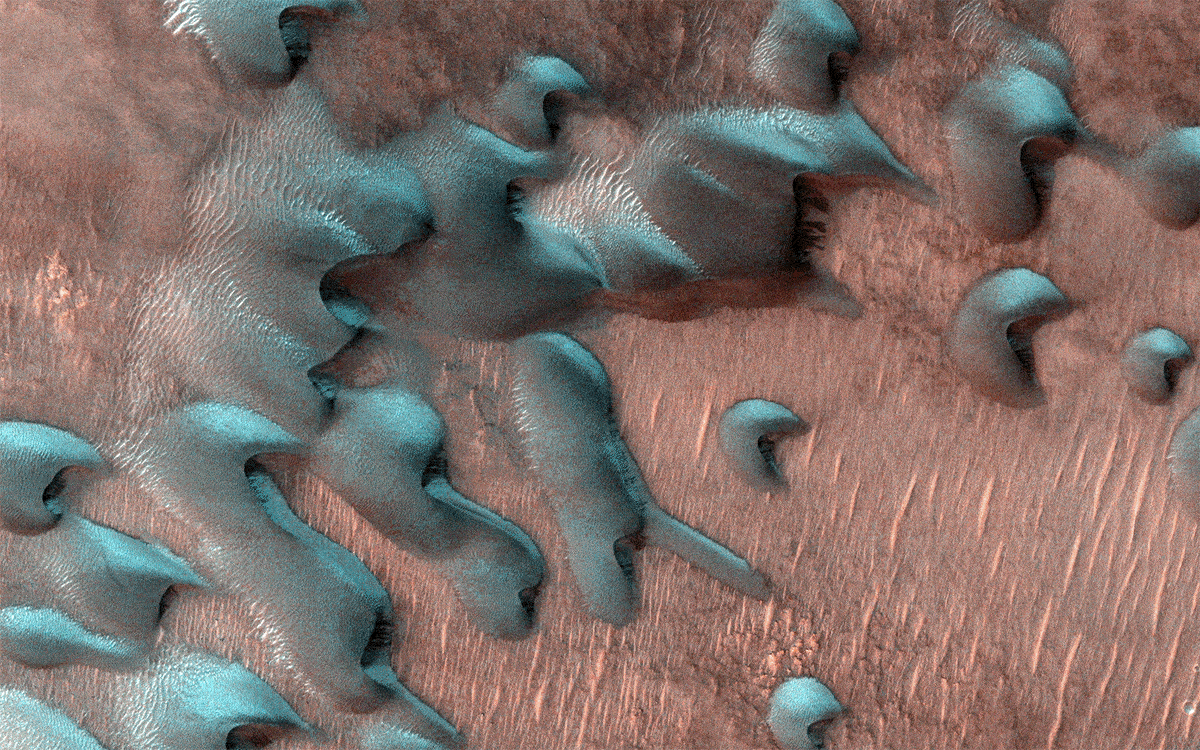
Küp şeklindeki kar, buzlu manzaralar ve don, Kızıl Gezegendeki en soğuk mevsimin bir parçasıdır.
kış geldiğinde[{” attribute=””>Mars, the surface is transformed into a truly otherworldly holiday scene. Snow, ice, and frost accompany the season’s sub-zero temperatures. Some of the coldest of these occur at the planet’s poles, where it gets as low as minus 190 degrees Fahrenheit (minus 123 degrees Celsius).

The HiRISE camera aboard NASA’s Mars Reconnaissance Orbiter captured these images of sand dunes covered by frost just after winter solstice. The frost here is a mixture of carbon dioxide (dry) ice and water ice and will disappear in a few months when spring arrives. Credit: NASA/JPL-Caltech/University of Arizona
Cold as it is, don’t expect snow drifts worthy of the Rocky Mountains. No region of Mars gets more than a few feet of snow, most of which falls over extremely flat areas. And the Red Planet’s elliptical orbit means it takes many more months for winter to come around: a single Mars year is around two Earth years.
Mars’ta da kar yağar, buz ve kırağı oluşur.[{” attribute=””>NASA’s spacecraft on and orbiting the Red Planet reveal the similarities to and differences from how we experience winter on Earth. Mars scientist Sylvain Piqueux of JPL explains in this video. Credit: NASA/JPL-Caltech
Still, the planet offers unique winter phenomena that scientists have been able to study, thanks to NASA’s robotic Mars explorers. Here are a few of the things they’ve discovered:
Two Kinds of Snow
Martian snow comes in two varieties: water ice and carbon dioxide, or dry ice. Because Martian air is so thin and the temperatures so cold, water-ice snow sublimates, or becomes a gas, before it even touches the ground. Dry-ice snow actually does reach the ground.
“Enough falls that you could snowshoe across it,” said Sylvain Piqueux, a Mars scientist at NASA’s Jet Propulsion Laboratory in Southern California whose research includes a variety of winter phenomena. “If you were looking for skiing, though, you’d have to go into a crater or cliffside, where snow could build up on a sloped surface.”

HiRISE captured these “megadunes,” also called barchans. Carbon dioxide frost and ice have formed over the dunes during the winter; as this starts to sublimate during spring, the darker-colored dune sand is revealed. Credit: NASA/JPL-Caltech/University of Arizona
How We Know It Snows
Snow occurs only at the coldest extremes of Mars: at the poles, under cloud cover, and at night. Cameras on orbiting spacecraft can’t see through those clouds, and surface missions can’t survive in the extreme cold. As a result, no images of falling snow have ever been captured. But scientists know it happens, thanks to a few special science instruments.
NASA’s Mars Reconnaissance Orbiter can peer through cloud cover using its Mars Climate Sounder instrument, which detects light in wavelengths imperceptible to the human eye. That ability has allowed scientists to detect carbon dioxide snow falling to the ground. And in 2008, NASA sent the Phoenix lander within 1,000 miles (about 1,600 kilometers) of Mars’ north pole, where it used a laser instrument to detect water-ice snow falling to the surface.
NASA bilim adamları, fırtınada kar parçacığı dağılımının boyutunu ve şeklini katman katman ölçebilirler. Küresel Yağış Ölçüm Misyonu, her üç saatte bir dünya çapındaki yeni nesil yağmur ve kar gözlemlerini sağlayacak uluslararası bir uydu projesidir. Kredi: NASA’nın Goddard Uzay Uçuş Merkezi/Ryan Fitzgibbons
buz küpleri
Su molekülleri donduklarında birbirlerine nasıl bağlı olduklarından dolayı, Dünya’daki kar tanelerinin altı kenarı vardır. Aynı ilke tüm kristaller için geçerlidir: atomların kendilerini düzenleme biçimleri kristalin şeklini belirler. Karbon dioksit söz konusu olduğunda, kuru buzdaki moleküller donduklarında her zaman dört şekle bağlanır.
Bicchio, “Karbondioksit buzunun simetrisi dört olduğundan, kuru kar tanelerinin küp şeklinde olacağını biliyoruz.” Dedi. “Mars iklimi sayesinde daha güvenli, bu kar tanelerinin insan saçı genişliğinden daha küçük olacağını söyleyebiliriz.”

HiRISE kamerası, kışın ortasındaki bir krater kenarının bu görüntüsünü yakaladı. Daha az güneş ışığı alan güneye bakan bir krater yamacı, bu gelişmiş renkli görüntüde maviyle gösterilen, düzensiz, parlak bir don oluşturur. Görsel kaynak: NASA/JPL-Caltech/Arizona Üniversitesi
Jack Frost gezgininizi kemiriyor
Hem su hem de karbondioksit Mars’ta don oluşturabilir ve her iki don türü de gezegende kardan daha yaygın olarak görülür. Viking iniş araçları, 1970’lerde Mars’ı incelediklerinde bir su donu gördüler, NASA’nın Odyssey yörünge aracı ise gördü Don oluşumu gözlenir ve süblimleşir sabah güneşi.

HiRISE, toprakta donmuş su buzunun Dünya’yı çokgenlere ayırdığı bu bahar sahnesini yakaladı. Şeffaf karbon dioksit buzu, güneş ışığının parlamasına ve havalandırma deliklerinden sızan gazları ısıtmasına izin vererek yüzeydeki daha koyu malzeme fanlarını ateşler (bu gelişmiş renkli resimde mavi gösterilmiştir). Görsel kaynak: NASA/JPL-Caltech/Arizona Üniversitesi
Kışın garip sonu
Belki de en şaşırtıcı keşif, yaratılan tüm buzun “erimeye” ve atmosfere süblimleşmeye başladığı kışın sonunda gelir. Bunu yaparken, bu buz, bilim adamlarına hatırlattığı garip, güzel şekiller alır. örümceklerVe Dalmaçyalı noktalarVe OmletVe isviçre peyniri.
Bu “erime” aynı zamanda gayzerlerin patlamasına da neden olur: şeffaf buz, güneş ışığının altındaki gazı ısıtmasına izin verir ve bu gaz sonunda patlayarak toz fanları çatıda. Bilim adamları, onlar hakkında daha fazla bilgi edinmenin bir yolu olarak bu fanları incelemeye çoktan başladılar. Mars rüzgarları hangi yönde esiyor?.

“Analist. Tutkulu zombi gurusu. Twitter uygulayıcısı. İnternet fanatiği. Dost pastırma hayranı.”





More Stories
Bilim insanları dünyadaki en büyük demir cevheri yataklarında milyar yıllık bir sırrı keşfetti
Fosillere göre tarih öncesi deniz ineği, timsah ve köpekbalığı tarafından yenildi
Büyük bir bindirme fayı üzerine yapılan yeni araştırma, bir sonraki büyük depremin yakın olabileceğini gösteriyor